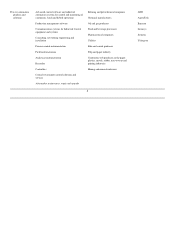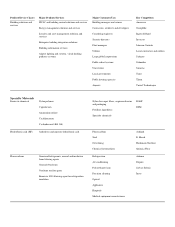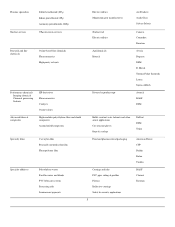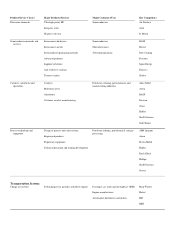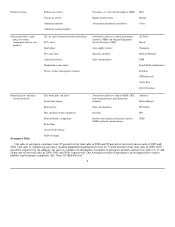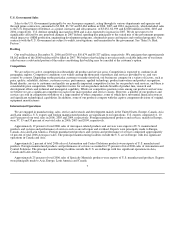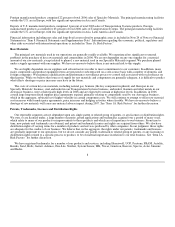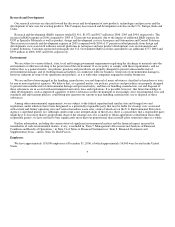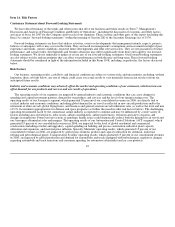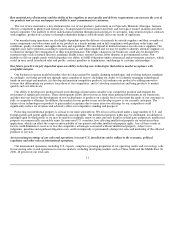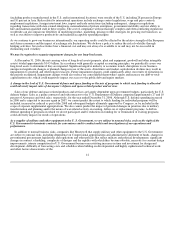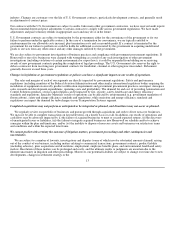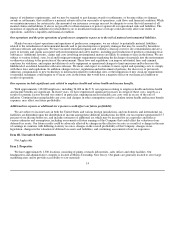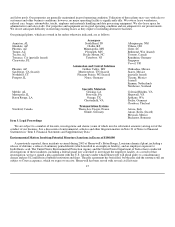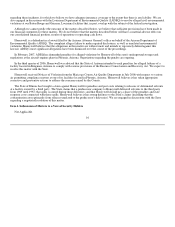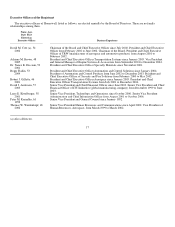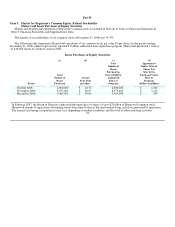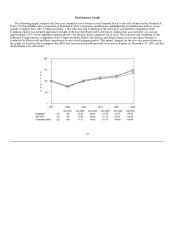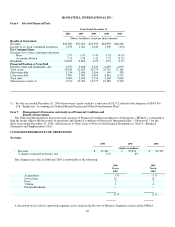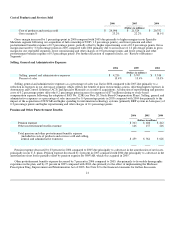Honeywell 2006 Annual Report Download - page 22
Download and view the complete annual report
Please find page 22 of the 2006 Honeywell annual report below. You can navigate through the pages in the report by either clicking on the pages listed below, or by using the keyword search tool below to find specific information within the annual report.
(including products manufactured in the U.S. and in international locations) were outside of the U.S. including 28 percent in Europe
and 10 percent in Asia. Risks related to international operations include exchange control regulations, wage and price controls,
employment regulations, foreign investment laws, import and trade restrictions (including embargoes), changes in regulations
regarding transactions with state-owned enterprises, nationalization of private enterprises, government instability and our ability to
hire and maintain qualified staff in these regions. The cost of compliance with increasingly complex and often conflicting regulations
worldwide can also impair our flexibility in modifying product, marketing, pricing or other strategies for growing our businesses, as
well as our ability to improve productivity and maintain acceptable operating margins.
As we continue to grow our businesses internationally, our operating results could be effected by the relative strength of the European
and Asian economies and the impact of exchange rate fluctuations. We do have a policy to reduce the risk of volatility through
hedging activities, but such activities bear a financial cost and may not always be available to us and may not be successful in
eliminating such volatility.
We may be required to recognize impairment charges for our long-lived assets.
At December 31, 2006, the net carrying value of long-lived assets (property, plant and equipment, goodwill and other intangible
assets) totaled approximately $14.5 billion. In accordance with generally accepted accounting principles, we periodically assess our
long-lived assets to determine if they are impaired. Significant negative industry or economic trends, disruptions to our business,
unexpected significant changes or planned changes in use of the assets, divestitures and market capitalization declines may result in
impairments to goodwill and other long-lived assets. Future impairment charges could significantly affect our results of operations in
the periods recognized. Impairment charges would also reduce our consolidated shareowners' equity and increase our debt-to-total-
capitalization ratio, which could negatively impact our access to the public debt and equity markets.
A change in the level of U.S. Government defense and space funding or the mix of programs to which such funding is allocated
could adversely impact sales of Aerospace's defense and space-related product and services.
Sales of our defense and space-related products and services are largely dependent upon government budgets, particularly the U.S.
defense budget. Sales as a prime contractor and subcontractor to the U. S. Department of Defense comprised approximately 27 and 10
percent of Aerospace and total sales, respectively, for the year ended December 31, 2006. Although U.S. defense spending increased
in 2006 and is expected to increase again in 2007, we cannot predict the extent to which funding for individual programs will be
included, increased or reduced as part of the 2008 and subsequent budgets ultimately approved by Congress, or be included in the
scope of separate supplemental appropriations. We also cannot predict the impact of potential changes in priorities due to military
transformation and planning and/or the nature of war-related activity on existing, follow-on or replacement programs. A shift in
defense spending to programs in which we do not participate and/or reductions in funding for or termination of existing programs
could adversely impact our results of operations.
As a supplier of military and other equipment to the U. S. Government, we are subject to unusual risks, such as the right of the
U.S. Government to terminate contracts for convenience and to conduct audits and investigations of our operations and
performance.
In addition to normal business risks, companies like Honeywell that supply military and other equipment to the U.S. Government
are subject to unusual risks, including dependence on Congressional appropriations and administrative allotment of funds, changes in
governmental procurement legislations and regulations and other policies that reflect military and political developments, significant
changes in contract scheduling, complexity of designs and the rapidity with which they become obsolete, necessity for constant design
improvements, intense competition for U.S. Government business necessitating increases in time and investment for design and
development, difficulty of forecasting costs and schedules when bidding on developmental and highly sophisticated technical work,
and other factors characteristic of the
12


